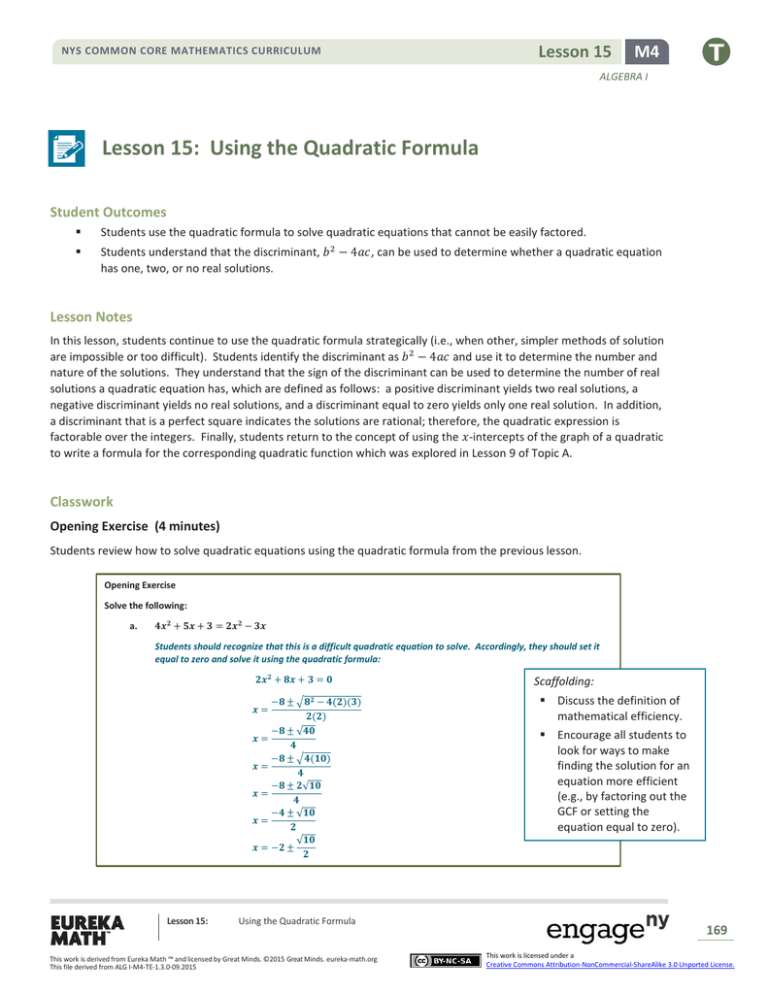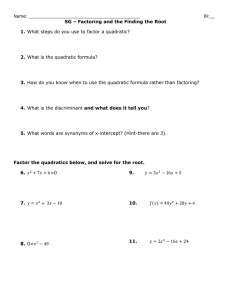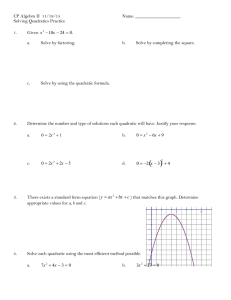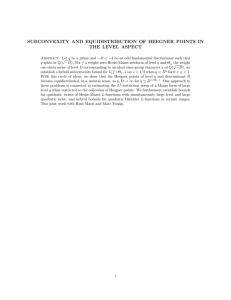Quadratic Formula Lesson Plan: Algebra I
advertisement

NYS COMMON CORE MATHEMATICS CURRICULUM Lesson 15 M4 ALGEBRA I Lesson 15: Using the Quadratic Formula Student Outcomes Students use the quadratic formula to solve quadratic equations that cannot be easily factored. Students understand that the discriminant, 𝑏 2 − 4𝑎𝑐, can be used to determine whether a quadratic equation has one, two, or no real solutions. Lesson Notes In this lesson, students continue to use the quadratic formula strategically (i.e., when other, simpler methods of solution are impossible or too difficult). Students identify the discriminant as 𝑏 2 − 4𝑎𝑐 and use it to determine the number and nature of the solutions. They understand that the sign of the discriminant can be used to determine the number of real solutions a quadratic equation has, which are defined as follows: a positive discriminant yields two real solutions, a negative discriminant yields no real solutions, and a discriminant equal to zero yields only one real solution. In addition, a discriminant that is a perfect square indicates the solutions are rational; therefore, the quadratic expression is factorable over the integers. Finally, students return to the concept of using the 𝑥-intercepts of the graph of a quadratic to write a formula for the corresponding quadratic function which was explored in Lesson 9 of Topic A. Classwork Opening Exercise (4 minutes) Students review how to solve quadratic equations using the quadratic formula from the previous lesson. Opening Exercise Solve the following: a. 𝟒𝒙𝟐 + 𝟓𝒙 + 𝟑 = 𝟐𝒙𝟐 − 𝟑𝒙 Students should recognize that this is a difficult quadratic equation to solve. Accordingly, they should set it equal to zero and solve it using the quadratic formula: 𝟐𝒙𝟐 + 𝟖𝒙 + 𝟑 = 𝟎 −𝟖 ± √𝟖𝟐 − 𝟒(𝟐)(𝟑) 𝟐(𝟐) −𝟖 ± √𝟒𝟎 𝒙= 𝟒 −𝟖 ± √𝟒(𝟏𝟎) 𝒙= 𝟒 −𝟖 ± 𝟐√𝟏𝟎 𝒙= 𝟒 −𝟒 ± √𝟏𝟎 𝒙= 𝟐 √𝟏𝟎 𝒙 = −𝟐 ± 𝟐 𝒙= Lesson 15: Using the Quadratic Formula This work is derived from Eureka Math ™ and licensed by Great Minds. ©2015 Great Minds. eureka-math.org This file derived from ALG I-M4-TE-1.3.0-09.2015 Scaffolding: Discuss the definition of mathematical efficiency. Encourage all students to look for ways to make finding the solution for an equation more efficient (e.g., by factoring out the GCF or setting the equation equal to zero). 169 This work is licensed under a Creative Commons Attribution-NonCommercial-ShareAlike 3.0 Unported License. Lesson 15 NYS COMMON CORE MATHEMATICS CURRICULUM M4 ALGEBRA I Check by substituting the approximated decimal value(s) into the original equation or by completing the square: 𝟐(𝒙𝟐 + 𝟒𝒙) = −𝟑 → 𝟐(𝒙𝟐 + 𝟒𝒙 + 𝟒) = −𝟑 + 𝟖 → 𝟐(𝒙 + 𝟐)𝟐 = 𝟓 (𝒙 + 𝟐)𝟐 = 𝟓 𝟓 𝟓 → 𝒙 + 𝟐 = ±√ → 𝒙 = −𝟐 ± √ 𝟐 𝟐 𝟐 (Have students use their calculators to check that these are the same decimal values as the previous solutions.) 𝒄𝟐 − 𝟏𝟒 = 𝟓𝒄 b. Initially, students may approach this problem by using the quadratic formula. While this approach works, encourage students to look for a more efficient pathway to the solution (in this case, to solve by factoring): 𝒄𝟐 − 𝟓𝒄 − 𝟏𝟒 = 𝟎 → (𝒄 − 𝟕)(𝒄 + 𝟐) = 𝟎 → 𝒄 = 𝟕 𝒐𝒓 − 𝟐 Checks: 𝟕𝟐 − 𝟏𝟒 = 𝟓(𝟕) → 𝟒𝟗 − 𝟏𝟒 = 𝟑𝟓 → 𝟑𝟓 = 𝟑𝟓 (−𝟐)𝟐 − 𝟏𝟒 = 𝟓(−𝟐) → 𝟒 − 𝟏𝟒 = −𝟏𝟎 → −𝟏𝟎 = −𝟏𝟎 Discussion (3 minutes) Before moving on, review the Opening Exercises. What are the differences between these two quadratic equations? Is one easier to solve than the other? Some students will have used the quadratic formula for both; some may have observed the second exercise to be more efficiently solved by factoring. Both need to be manipulated before a decision can be made. Is one pathway to solution more correct than another? Ultimately, students should be aware that while there are many ways to arrive at a correct solution, some methods are more efficient than others. Exercises (10 minutes) Have students solve the following three standard form quadratic equations independently using the quadratic formula. Ask them to watch for special circumstances in each. Exercises Solve Exercises 1–5 using the quadratic formula. 1. 𝒙𝟐 − 𝟐𝒙 + 𝟏 = 𝟎 𝒂 = 𝟏, 𝒃 = −𝟐, 𝒄 = 𝟏 𝒙= −(−𝟐) ± √(−𝟐)𝟐 − 𝟒(𝟏)(𝟏) 𝟐 ± √𝟎 = =𝟏 𝟐(𝟏) 𝟐 This exercise factors easily as a perfect square, (𝑥 − 1)2 = 0, with a solution of 𝑥 = 1. However, notice that when we use the quadratic formula, we can see that the number under the radical sign equals zero. This translates as one real solution which is also rational. We also sometimes call this a double solution (or a double root) since the factors of the perfect square give the equation (𝑥 − 1)(𝑥 − 1) = 0, for which we find that there are two identical solutions, both of which are 1. Lesson 15: Using the Quadratic Formula This work is derived from Eureka Math ™ and licensed by Great Minds. ©2015 Great Minds. eureka-math.org This file derived from ALG I-M4-TE-1.3.0-09.2015 170 This work is licensed under a Creative Commons Attribution-NonCommercial-ShareAlike 3.0 Unported License. NYS COMMON CORE MATHEMATICS CURRICULUM Lesson 15 M4 ALGEBRA I 𝟑𝒃𝟐 + 𝟒𝒃 + 𝟖 = 𝟎 2. 𝒂 = 𝟑, 𝒃 = 𝟒, 𝒄 = 𝟖 𝒃= −𝟒 ± √𝟒𝟐 − 𝟒(𝟑)(𝟖) −𝟒 ± √−𝟖𝟎 = = ??? 𝟐(𝟑) 𝟔 This exercise may be confusing. Point out that substituting into the quadratic formula yields a negative square root, which is not a real number. Have students try finding √−80 on their calculators. They should get an error message or a message that says non-real answer. (Note that some calculators will produce an answer in terms of 𝑖 when in complex mode.) Explain that there is no real number whose square is a negative number. So, when we find that the number under the radical is negative, we say that the equation has no real solutions. 𝟐𝒕𝟐 + 𝟕𝒕 − 𝟒 = 𝟎 3. 𝒂 = 𝟐, 𝒃 = 𝟕, 𝒄 = −𝟒 𝒕= −𝟕 ± √𝟕𝟐 − 𝟒(𝟐)(−𝟒) −𝟕 ± √𝟒𝟗 + 𝟑𝟐 −𝟕 ± √𝟖𝟏 −𝟕 ± 𝟗 𝟏 = = = = or − 𝟒 𝟐(𝟐) 𝟒 𝟒 𝟒 𝟐 Point out that this time, the value under the radical, 81, is a perfect square. This translates into two rational solutions. 𝒒𝟐 − 𝟐𝒒 − 𝟏 = 𝟎 4. 𝒂 = 𝟏, 𝒃 = −𝟐, 𝒄 = −𝟏 𝒒= −(−𝟐) ± √(−𝟐)𝟐 − 𝟒(𝟏)(−𝟏) 𝟐 ± √𝟖 𝟐 ± 𝟐√𝟐 = = = 𝟏 ± √𝟐 𝟐(𝟏) 𝟐 𝟐 𝒎𝟐 − 𝟒 = 𝟑 5. 𝒂 = 𝟏, 𝒃 = 𝟎, 𝒄 = −𝟕 𝒎= 𝟎 ± √𝟎𝟐 − 𝟒(−𝟕) 𝟎 ± √𝟐𝟖 𝟎 ± 𝟐√𝟕 = = = 𝟎 ± √𝟕 = ±√𝟕 𝟐(𝟏) 𝟐 𝟐 Point out that these last two times, the values under the radicals were not perfect squares but were greater than zero. This translated into two irrational solutions. Discussion (4 minutes) Describe the solutions of these quadratic equations in your own words. This is where you can delve into what makes these equations different. We usually get two solutions, but the first equation has only one solution. We couldn’t solve the second problem because we get a negative under the radical sign. The third solution has a perfect square under the radical so that the square root is eliminated from the answer. The last two are not perfect squares under the radical but do have a positive value; therefore, both answers are irrational. Lesson 15: Using the Quadratic Formula This work is derived from Eureka Math ™ and licensed by Great Minds. ©2015 Great Minds. eureka-math.org This file derived from ALG I-M4-TE-1.3.0-09.2015 171 This work is licensed under a Creative Commons Attribution-NonCommercial-ShareAlike 3.0 Unported License. Lesson 15 NYS COMMON CORE MATHEMATICS CURRICULUM M4 ALGEBRA I The expression under the radical is called the discriminant: 𝑏 2 − 4𝑎𝑐. The value of the discriminant determines the number and nature of the solutions for a quadratic equation. As we saw in the Opening Exercises, when the discriminant is positive, then we have ±√(positive number), which yields two real solutions (two rational solutions if the value is a perfect square). When the discriminant equals zero, as it did in Example 1, then we have ±√0, which yields only one solution, −𝑏 2𝑎 . When the discriminant is a negative number, then we have ±√(negative number), which can never lead to a real solution. Show students the following graphs of quadratic equations. Project or sketch them on the board or screen. What are the differences among these three graphs? Which of these graphs belongs to a quadratic equation with a positive discriminant? Which belongs to a quadratic equation with a negative discriminant? Which graph has a discriminant equal to zero? The first graph touches the 𝑥-axis exactly once, corresponding to one real root and a discriminant equal to zero. The second graph lies entirely above the 𝑥-axis, so it has no real roots; therefore, its discriminant must be negative. The third graph intersects the 𝑥-axis in two points, so it has two real roots; therefore, its discriminant is positive. Note that the third graph looks like it may have rational solutions since it appears that the intercepts are 1.5 and 4.5. Remind students that graphs are excellent for estimating, but algebra is used to find the exact solutions. Exercises 6–10 (7 minutes) For Exercises 6–9, determine the number of real solutions for each quadratic equation without solving. 6. 𝒑𝟐 + 𝟕𝒑 + 𝟑𝟑 = 𝟖 − 𝟑𝒑 𝒂 = 𝟏, 𝒃 = 𝟏𝟎, 𝒄 = 𝟐𝟓 → 𝟏𝟎𝟐 − 𝟒(𝟏)(𝟐𝟓) = 𝟎 → one real solution 7. 𝟕𝒙𝟐 + 𝟐𝒙 + 𝟓 = 𝟎 𝒂 = 𝟕, 𝒃 = 𝟐, 𝒄 = 𝟓 → 𝟐𝟐 − 𝟒(𝟕)(𝟓) = −𝟏𝟑𝟔 → no real solutions Lesson 15: Using the Quadratic Formula This work is derived from Eureka Math ™ and licensed by Great Minds. ©2015 Great Minds. eureka-math.org This file derived from ALG I-M4-TE-1.3.0-09.2015 172 This work is licensed under a Creative Commons Attribution-NonCommercial-ShareAlike 3.0 Unported License. Lesson 15 NYS COMMON CORE MATHEMATICS CURRICULUM M4 ALGEBRA I 𝟐𝒚𝟐 + 𝟏𝟎𝒚 = 𝒚𝟐 + 𝟒𝒚 − 𝟑 8. 𝒂 = 𝟏, 𝒃 = 𝟔, 𝒄 = 𝟑 → 𝟔𝟐 − 𝟒(𝟏)(𝟑) = 𝟐𝟒 → two real solutions 𝟒𝒛𝟐 + 𝟗 = −𝟒𝒛 9. 𝒂 = 𝟒, 𝒃 = 𝟒, 𝒄 = 𝟗 → 𝟒𝟐 − 𝟒(𝟒)(𝟗) = −𝟏𝟐𝟖 → no real solutions 10. On the line below each graph, state whether the discriminant of each quadratic equation is positive, negative, or equal to zero. Then, identify which graph matches the discriminants below. Graph 1 Equal to zero Graph 2 Graph 3 Negative Discriminant A: (−𝟐)𝟐 − 𝟒(𝟏)(𝟐) Graph: 𝟐 Discriminant B: (−𝟒)𝟐 − 𝟒(−𝟏)(−𝟒) Graph: 𝟏 Positive Discriminant C: (−𝟒)𝟐 − 𝟒(𝟏)(𝟎) Graph: 𝟒 Graph 4 Positive (perfect square) Discriminant D: 𝟖𝟐 − 𝟒(−𝟏)(−𝟏𝟑) Graph: 𝟑 Discussion (3 minutes) Before students work on Exercise 11, have the following discussion. If a quadratic function is written in factored form, 𝑓(𝑥) = 𝑎(𝑥 − 𝑚)(𝑥 − 𝑛), what key feature of the graph is easily recognizable? The 𝑥-intercepts, 𝑥 = 𝑚 and 𝑥 = 𝑛. (Students may also note that the direction of opening can be seen by looking at the value of 𝑎.) Is the converse of this true? In other words, if we are given the 𝑥-intercepts, 𝑥 = 𝑚 and 𝑥 = 𝑛, of the graph of a quadratic function, can we write a formula for the function? Students will likely say yes. Students did exercises like this in Lesson 9, but we haven’t proven that this holds true for all quadratic functions. Give students time to work on Exercise 11, guiding them through parts (b) and (c) as needed. Students should see that even when the 𝑥-intercepts are irrational numbers, they can still be used to write the factored form of the corresponding quadratic function. In Algebra II, students extend this idea to polynomials of any degree. Lesson 15: Using the Quadratic Formula This work is derived from Eureka Math ™ and licensed by Great Minds. ©2015 Great Minds. eureka-math.org This file derived from ALG I-M4-TE-1.3.0-09.2015 173 This work is licensed under a Creative Commons Attribution-NonCommercial-ShareAlike 3.0 Unported License. Lesson 15 NYS COMMON CORE MATHEMATICS CURRICULUM M4 ALGEBRA I Exercise 11 (7 minutes) 11. Consider the quadratic function 𝒇(𝒙) = 𝒙𝟐 − 𝟐𝒙 − 𝟒. a. Use the quadratic formula to find the 𝒙-intercepts of the graph of the function. 𝒙 = 𝟏 + √𝟓 and 𝒙 = 𝟏 − √𝟓 b. Use the 𝒙-intercepts to write the quadratic function in factored form. 𝒇(𝒙) = (𝒙 − (𝟏 + √𝟓)) (𝒙 − (𝟏 − √𝟓)) c. Show that the function from part (b) written in factored form is equivalent to the original function. 𝒇(𝒙) = 𝒙𝟐 − (𝟏 + √𝟓)𝒙 − (𝟏 − √𝟓)𝒙 + (𝟏 + √𝟓)(𝟏 − √𝟓) 𝒇(𝒙) = 𝒙𝟐 − 𝒙 − √𝟓𝒙 − 𝒙 + √𝟓𝒙 + 𝟏 − 𝟓 𝒇(𝒙) = 𝒙𝟐 − 𝟐𝒙 − 𝟒 This exercise still does not exactly prove that this holds true for all quadratic functions, regardless of the types of solutions. If time permits, work the extension as a class. Extension: Consider the quadratic equation 𝒂𝒙𝟐 + 𝒃𝒙 + 𝒄 = 𝟎. a. Write the equation in factored form, 𝒂(𝒙 − 𝒎)(𝒙 − 𝒏) = 𝟎, where 𝒎 and 𝒏 are the solutions to the equation. The solutions to the equation 𝒂𝒙𝟐 + 𝒃𝒙 + 𝒄 = 𝟎 are 𝒙 = 𝟐 𝟐 −𝒃+√𝒃 −𝟒𝒂𝒄 −𝒃−√𝒃 −𝟒𝒂𝒄 and 𝒙 = . So in factored 𝟐𝒂 𝟐𝒂 form the equation would be 𝒂 (𝒙 − b. −𝒃 + √𝒃𝟐 − 𝟒𝒂𝒄 −𝒃 − √𝒃𝟐 − 𝟒𝒂𝒄 ) (𝒙 − )=𝟎 𝟐𝒂 𝟐𝒂 Show that the equation from part (a) is equivalent to the original equation. −𝒃 + √𝒃𝟐 − 𝟒𝒂𝒄 −𝒃 − √𝒃𝟐 − 𝟒𝒂𝒄 −𝒃 + √𝒃𝟐 − 𝟒𝒂𝒄 −𝒃 − √𝒃𝟐 − 𝟒𝒂𝒄 𝒃𝟐 − (𝒃𝟐 − 𝟒𝒂𝒄) 𝒂 (𝒙 − 𝒙− 𝒙+ ) (𝒙 − ) = 𝒂 (𝒙𝟐 − ) 𝟐𝒂 𝟐𝒂 𝟐𝒂 𝟐𝒂 𝟒𝒂𝟐 𝒃 − √𝒃𝟐 − 𝟒𝒂𝒄 𝒃 + √𝒃𝟐 − 𝟒𝒂𝒄 𝒄 = 𝒂(𝒙𝟐 + ( + )𝒙 + 𝟐𝒂 𝟐𝒂 𝒂 𝟐𝒃 𝒄 𝒙+ ) 𝟐𝒂 𝒂 = 𝒂𝒙𝟐 + 𝒃𝒙 + 𝒄 = 𝒂 (𝒙𝟐 + Lesson 15: Using the Quadratic Formula This work is derived from Eureka Math ™ and licensed by Great Minds. ©2015 Great Minds. eureka-math.org This file derived from ALG I-M4-TE-1.3.0-09.2015 174 This work is licensed under a Creative Commons Attribution-NonCommercial-ShareAlike 3.0 Unported License. Lesson 15 NYS COMMON CORE MATHEMATICS CURRICULUM M4 ALGEBRA I Closing (2 minutes) The quadratic formula can be used to solve any quadratic equation in standard form. The discriminant is the part of the quadratic formula that is under the radical. It can be used to determine the nature and number of solutions for a quadratic equation and whether the quadratic expression can be factored over the integers. Lesson Summary You can use the sign of the discriminant, 𝒃𝟐 − 𝟒𝒂𝒄, to determine the number of real solutions to a quadratic equation in the form 𝒂𝒙𝟐 + 𝒃𝒙 + 𝒄 = 𝟎, where 𝒂 ≠ 𝟎. If the equation has a positive discriminant, there are two real solutions. A negative discriminant yields no real solutions, and a discriminant equal to zero yields only one real solution. Exit Ticket (5 minutes) Lesson 15: Using the Quadratic Formula This work is derived from Eureka Math ™ and licensed by Great Minds. ©2015 Great Minds. eureka-math.org This file derived from ALG I-M4-TE-1.3.0-09.2015 175 This work is licensed under a Creative Commons Attribution-NonCommercial-ShareAlike 3.0 Unported License. Lesson 15 NYS COMMON CORE MATHEMATICS CURRICULUM M4 ALGEBRA I Name Date Lesson 15: Using the Quadratic Formula Exit Ticket 1. Solve the following equation using the quadratic formula: 3𝑥 2 + 6𝑥 + 8 = 6. 2. Is the quadratic formula the most efficient way to solve this equation? Why or why not? 3. How many zeros does the function 𝑓(𝑥) = 3𝑥 2 + 6𝑥 + 2 have? Explain how you know. Lesson 15: Using the Quadratic Formula This work is derived from Eureka Math ™ and licensed by Great Minds. ©2015 Great Minds. eureka-math.org This file derived from ALG I-M4-TE-1.3.0-09.2015 176 This work is licensed under a Creative Commons Attribution-NonCommercial-ShareAlike 3.0 Unported License. Lesson 15 NYS COMMON CORE MATHEMATICS CURRICULUM M4 ALGEBRA I Exit Ticket Sample Solutions 1. Solve the following equation using the quadratic formula: 𝟑𝒙𝟐 + 𝟔𝒙 + 𝟖 = 𝟔. 𝟑𝒙𝟐 + 𝟔𝒙 + 𝟐 = 𝟎 → 𝒙= −𝟔 ± √𝟔𝟐 − 𝟒(𝟑)(𝟐) 𝟐(𝟑) −𝟔 ± √𝟑𝟔 − 𝟐𝟒 𝟔 −𝟔 ± √𝟏𝟐 𝒙= 𝟔 𝒙= −𝟔 ± √𝟒(𝟑) 𝟔 −𝟔 ± 𝟐√𝟑 𝒙= 𝟔 −𝟑 ± √𝟑 √𝟑 𝒙= or − 𝟏 ± 𝟑 𝟑 𝒙= 2. Is the quadratic formula the most efficient way to solve this equation? Why or why not? This is a personal preference. Some may consider the quadratic formula to be more efficient, while others may prefer completing the square. After the leading coefficient is factored out, the linear term coefficient is still even, making this a good candidate for completing the square. 3. How many zeros does the function 𝒇(𝒙) = 𝟑𝒙𝟐 + 𝟔𝒙 + 𝟐 have? Explain how you know. Since the discriminant of the original equation is positive, 𝟏𝟐, and yields two real solutions, the function must have two zeros. OR After solving the equation 𝟑𝒙𝟐 + 𝟔𝒙 + 𝟐 = 𝟎, I found that there were two irrational solutions. This means that the corresponding function has two zeros. Problem Set Sample Solutions The Problem Set is identical in scope and style to the exercise set from class. Students are not being asked to solve the quadratic equations in each question, only to use the discriminant to find the number of roots or to use the number of roots to discuss the value of the discriminant. Without solving, determine the number of real solutions for each quadratic equation. 1. 𝒃𝟐 − 𝟒𝒃 + 𝟑 = 𝟎 𝒂 = 𝟏, 𝒃 = −𝟒, 𝒄 = 𝟑 → (−𝟒)𝟐 − 𝟒(𝟏)(𝟑) = 𝟒 → two real solutions 2. 𝟐𝒏𝟐 + 𝟕 = −𝟒𝒏 + 𝟓 𝒂 = 𝟐, 𝒃 = 𝟒, 𝒄 = 𝟐 → (𝟒)𝟐 − 𝟒(𝟐)(𝟐) = 𝟎 → one real solution 3. 𝒙 − 𝟑𝒙𝟐 = 𝟓 + 𝟐𝒙 − 𝒙𝟐 𝒂 = −𝟐, 𝒃 = −𝟏, 𝒄 = −𝟓 → (−𝟏)𝟐 − 𝟒(−𝟐)(−𝟓) = −𝟑𝟗 → no real solutions Lesson 15: Using the Quadratic Formula This work is derived from Eureka Math ™ and licensed by Great Minds. ©2015 Great Minds. eureka-math.org This file derived from ALG I-M4-TE-1.3.0-09.2015 177 This work is licensed under a Creative Commons Attribution-NonCommercial-ShareAlike 3.0 Unported License. Lesson 15 NYS COMMON CORE MATHEMATICS CURRICULUM M4 ALGEBRA I 4. 𝟒𝒒 + 𝟕 = 𝒒𝟐 − 𝟓𝒒 + 𝟏 𝒂 = −𝟏, 𝒃 = 𝟗, 𝒄 = 𝟔 → (𝟗)𝟐 − 𝟒(−𝟏)(𝟔) = 𝟏𝟎𝟓 → two real solutions Based on the graph of each quadratic function, 𝒚 = 𝒇(𝒙), determine the number of real solutions for each corresponding quadratic equation, 𝒇(𝒙) = 𝟎. 5. One real solution 6. No real solutions 7. Two real solutions Lesson 15: Using the Quadratic Formula This work is derived from Eureka Math ™ and licensed by Great Minds. ©2015 Great Minds. eureka-math.org This file derived from ALG I-M4-TE-1.3.0-09.2015 178 This work is licensed under a Creative Commons Attribution-NonCommercial-ShareAlike 3.0 Unported License. Lesson 15 NYS COMMON CORE MATHEMATICS CURRICULUM M4 ALGEBRA I 8. One real solution 9. Consider the quadratic function 𝒇(𝒙) = 𝒙𝟐 − 𝟕. a. Find the 𝒙-intercepts of the graph of the function. 𝒙 = ±√𝟕 b. Use the 𝒙-intercepts to write the quadratic function in factored form. 𝒇(𝒙) = (𝒙 − √𝟕)(𝒙 + √𝟕) c. Show that the function from part (b) written in factored form is equivalent to the original function. 𝒇(𝒙) = (𝒙 − √𝟕)(𝒙 + √𝟕) = 𝒙𝟐 + √𝟕𝒙 − √𝟕𝒙 − 𝟕 = 𝒙𝟐 − 𝟕 10. Consider the quadratic function 𝒇(𝒙) = −𝟐𝒙𝟐 + 𝒙 + 𝟓. a. Find the 𝒙-intercepts of the graph of the function. 𝒙= b. 𝟏 ± √𝟒𝟏 𝟒 Use the 𝒙-intercepts to write the quadratic function in factored form. 𝒇(𝒙) = −𝟐 (𝒙 − c. 𝟏 + √𝟒𝟏 𝟏 − √𝟒𝟏 ) (𝒙 − ) 𝟒 𝟒 Show that the function from part (b) written in factored form is equivalent to the original function. 𝒇(𝒙) = −𝟐 (𝒙 − 𝟏 + √𝟒𝟏 𝟏 − √𝟒𝟏 𝟏 + √𝟒𝟏 𝟏 − √𝟒𝟏 𝟓 𝟏 𝟓 𝒙− 𝒙 − ) = −𝟐 (𝒙𝟐 − 𝒙 − ) ) (𝒙 − ) = −𝟐 (𝒙𝟐 − 𝟒 𝟒 𝟒 𝟒 𝟐 𝟐 𝟐 = −𝟐𝒙𝟐 + 𝒙 + 𝟓 Lesson 15: Using the Quadratic Formula This work is derived from Eureka Math ™ and licensed by Great Minds. ©2015 Great Minds. eureka-math.org This file derived from ALG I-M4-TE-1.3.0-09.2015 179 This work is licensed under a Creative Commons Attribution-NonCommercial-ShareAlike 3.0 Unported License.




